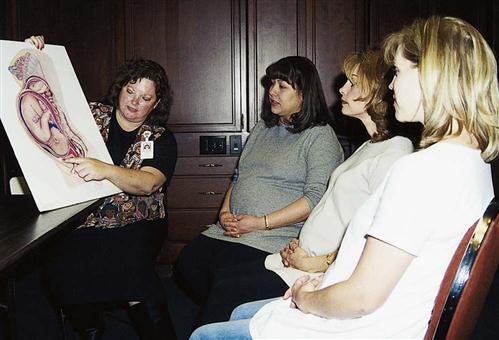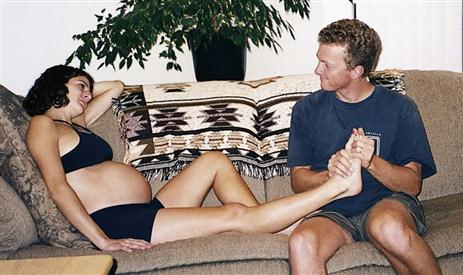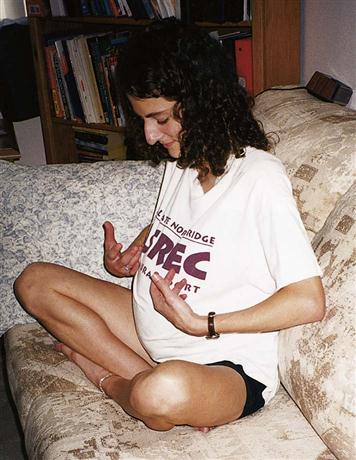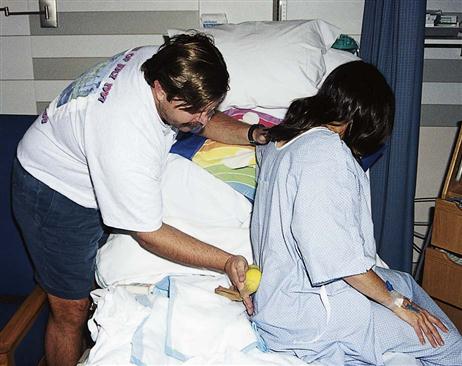Nursing Management of Pain During Labor and Birth
Objectives
1. Define each key term listed.
2. List the common types of classes offered to childbearing families.
3. Describe factors that influence a woman’s comfort during labor.
4. Describe the methods of childbirth preparation.
7. Discuss the advantages and limitations of pharmacological methods of pain management.
8. Explain each type of pharmacological pain management, including the nursing role for each.
Key Terms
blood patch (p. 169)
Bradley method (p. 160)
cleansing breath (p. 163)
effleurage (ĕf-loo-RĂHZH, p. 162)
endorphins (ĕn-DŎR-fĭnz, p. 159)
focal point (p. 162)
Lamaze method (p. 160)
opioids (Ō-pē-oidz, p. 165)
pain threshold (p. 159)
pain tolerance (p. 159)
![]() http://evolve.elsevier.com/Leifer
http://evolve.elsevier.com/Leifer
Pregnant women are usually interested in how labor will feel and how they can manage the experience. Preparation for childbirth is important.
Education for Childbearing
Various classes are offered to women during pregnancy by most hospitals and freestanding birth centers to help women adjust to pregnancy, cope with labor, and prepare for life with an infant (Figure 7-1). Women who plan a home birth usually prepare intensely because they want to avoid medications and other interventions associated with hospital births.

Types of Classes Available
Classes during pregnancy focus on topics that contribute to good outcomes for the mother and infant (see Health Promotion box). Special classes prepare other family members for the birth and the new infant. Other classes are sometimes available, including:
Variations of Basic Childbirth Preparation Classes
Refresher Classes
Refresher classes consist of one to three sessions to review the material learned during a previous pregnancy. Ways to help siblings adjust to the new baby and a review of infant feeding are often included.
Cesarean Birth Classes
Classes for women who expect a cesarean birth help the woman and her support person to understand the reasons for this method of delivery and anticipate what is likely to occur during and after surgery.
Vaginal Birth after Cesarean Classes
Women in vaginal birth after cesarean (VBAC) classes may need to express unresolved feelings about their previous cesarean birth. Depending on the reason for the cesarean delivery, they may be more anxious about the forthcoming labor.
Adolescent Childbirth Preparation Classes
A pregnant adolescent’s needs are different from those of an adult. Adolescents are therefore usually uncomfortable in regular childbirth preparation classes. They are often single mothers and have a more immature perception of birth and child rearing. Some are not old enough to drive or do not have access to a car. They cannot attend classes that target working adults. The content of classes for adolescents is tailored to their special needs. Because acceptance by their peer group is important to adolescents, the girls are a significant source of support for each other. Classes may be held in the school setting. Expectant fathers may be included.
Basic Content of All Childbirth Preparation Classes
Regardless of the specific method taught, most classes are similar in basic content (see the Health Promotion box). Many of the techniques covered can also be used to help the unprepared woman during labor. The woman who learns about the changes produced by pregnancy and childbirth is less likely to respond with fear and tension during labor. Information about cesarean birth is usually included.
Benefits of Exercise
Conditioning exercises such as the pelvic rock, tailor sitting, and shoulder circling prepare the woman’s muscles for the demands of birth (see Chapter 4). These exercises also relieve the back discomfort common during late pregnancy.
Pain Control Methods for Labor
The woman and her partner learn a variety of techniques that may be used during labor as needed (Figure 7-2). These are some examples:

These techniques are most effective if learned before labor begins. See Box 7-1 for selected nonpharmacological pain relief techniques.
Childbirth and Pain
Pain is an unpleasant and distressing symptom that is personal and subjective. No one can feel another’s pain, but empathic nursing care helps to alleviate pain and helps the woman cope with it.
How Childbirth Pain Differs from Other Pain
Several factors distinguish childbirth pain from other types of pain:
• It is part of a normal birth process.
• The woman has several months to prepare for pain management.
Pain is usually a symptom of injury or illness, yet pain during labor is an almost universal part of the normal process of birth. Although excessive pain is detrimental to the labor process, pain also can be beneficial. It may cause a woman to feel vulnerable and seek shelter and help from others. Pain often motivates her to assume different body positions, which can facilitate the normal descent of the fetus. Birth pain lasts for hours, as opposed to days or weeks. Labor ends with the birth of an infant, followed by a rapid and nearly total cessation of pain.
Factors That Influence Labor Pain
Several factors lead to pain during labor and influence the amount of pain a woman experiences. Other factors influence a woman’s response to labor pain and her ability to tolerate it.
Pain Threshold and Pain Tolerance
Two terms are often used interchangeably to describe pain, although they have different meanings. Pain threshold, also called pain perception, is the least amount of sensation that a person perceives as painful. Pain threshold is fairly constant, and it varies little under different conditions. Pain tolerance is the amount of pain one is willing to endure. Unlike the pain threshold, one’s pain tolerance can change under different conditions. A primary nursing responsibility is to modify as many factors as possible so that the woman can tolerate the pain of labor.
Sources of Pain During Labor
The following physical factors contribute to pain during labor:
Physical Factors That Modify Pain
Several physical factors influence the amount of pain a woman feels or is willing to tolerate during labor.
Central Nervous System Factors
Gate control theory.
The gate control theory explains how pain impulses reach the brain for interpretation. It supports several nonpharmacological methods of pain control. According to this theory, pain is transmitted through small-diameter nerve fibers. However, the stimulation of large-diameter nerve fibers temporarily interferes with the conduction of impulses through small-diameter fibers. Techniques to stimulate large-diameter fibers and “close the gate” to painful impulses include massage, palm and fingertip pressure, and heat and cold applications.
Endorphins.
Endorphins are natural body substances similar to morphine. Endorphin levels increase during pregnancy and reach a peak during labor. Endorphins may explain why women in labor often need smaller doses of an analgesic or anesthetic than might be expected in a similarly painful experience.
Maternal Condition
Cervical Readiness.
The mother’s cervix normally undergoes prelabor changes that facilitate effacement and dilation in labor (see Chapter 6). If her cervix does not make these changes (ripening), more contractions are needed to cause effacement and dilation.
Pelvis.
The size and shape of the pelvis significantly influences how readily the fetus can descend through it. Pelvic abnormalities can result in a longer labor and greater maternal fatigue. In addition, the fetus may remain in an abnormal presentation or position, which interferes with the mechanisms of labor.
Labor Intensity.
The woman who has a short, intense labor often experiences more pain than the woman whose birth process is more gradual. Contractions are intense and frequent, and their onset may be sudden. The cervix, vagina, and perineum stretch more abruptly than during a gentler labor. Contractions come so fast that the woman cannot recover from one before another begins. In addition, a rapid labor limits the woman’s choices for pharmacological pain control.
Fatigue.
Fatigue reduces pain tolerance and a woman’s ability to use coping skills. Many women are tired when labor begins because sleep during late pregnancy is difficult. The active fetus, frequent urination, and shortness of breath when lying down all interrupt sleep.
Fetal Presentation and Position
The fetal presenting part acts as a wedge to efface and dilate the cervix as each contraction pushes it downward. The fetal head is a smooth, rounded wedge that most effectively causes effacement and dilation of the round cervix. The fetus in an abnormal presentation or position applies uneven pressure to the cervix, resulting in less effective effacement and dilation and thus prolonging the labor and delivery process.
The fetus usually turns during early labor so that the occiput is in the front left or right quadrant of the mother’s pelvis (occiput anterior positions) (see Figures 6-7 and 6-8). If the fetal occiput is in a posterior pelvic quadrant, each contraction pushes it against the mother’s sacrum, resulting in persistent and poorly relieved back pain (back labor). Labor is often longer with this fetal position.
Interventions of Caregivers
Although they are intended to promote maternal and fetal safety, several common interventions may add to pain during labor. These are some examples:
Psychosocial Factors That Modify Pain
Several psychosocial variables alter the pain a woman experiences during labor. Many of these variables interrelate with one another and with physical factors.
Culture influences how a woman feels about pregnancy and birth and how she reacts to pain during childbirth. See Table 6-1 for selected traditional cultural practices during labor and delivery.
Nonpharmacological Childbirth Preparation and Pain Management
Nonpharmacological pain control methods are important, even if the woman receives medication or an anesthetic. Most pharmacological methods cannot be instituted until labor is well-established because they tend to slow the progress of labor. Nonpharmacological methods help the woman to cope with labor before it has advanced far enough for her to be given medication. In addition, most medications for labor do not eliminate pain, and the woman will need nonpharmacological methods to manage the discomfort that remains. Nonpharmacological methods are usually the only realistic option if the woman comes to the hospital in advanced labor.
Advantages
There are several advantages to nonpharmacological methods if pain control is adequate. Poorly relieved pain increases fear and anxiety, thus diverting blood flow from the uterus and impairing the normal labor process. It also reduces the pleasure of this extraordinary experience. Nonpharmacological methods do not harm the mother or fetus. They do not slow labor if they provide adequate pain control. They carry no risk for allergy or adverse drug effects.
Limitations
For best results, nonpharmacological measures should be rehearsed before labor begins. They can be taught to the unprepared woman, preferably during early labor, when she is anxious enough to be interested yet comfortable enough to learn. The nurse may help the woman use several key techniques of nonpharmacological pain control during labor. If the woman and her partner attended childbirth preparation classes, the nurse builds on their knowledge during labor (Box 7-1).
Childbirth Preparation Methods
Most childbirth preparation classes are based on one of several methods. The basic method is often modified to meet the specific needs of the women who attend.
Dick-Read Method.
Grantly Dick-Read was an English physician who introduced the concept of a fear-tension-pain cycle during labor. He believed that fear of childbirth contributed to tension, which resulted in pain. His methods include education and relaxation techniques to interrupt the cycle.
Bradley Method.
The Bradley method was originally called “husband-coached childbirth” and was the first to include the father as an integral part of labor. It emphasizes slow abdominal breathing and relaxation techniques.
Lamaze Method.
The Lamaze method, also called the psychoprophylactic method, is the basis of most childbirth preparation classes in the United States. It uses mental techniques that condition the woman to respond to contractions with relaxation rather than tension. Other mental and breathing techniques occupy her mind and limit the brain’s ability to interpret labor sensations as painful. The Lamaze breathing technique should be no slower than half of the woman’s baseline respiratory rate and no faster than twice the baseline rate.
Nonpharmacological Techniques
Relaxation Techniques.
The ability to release tension is a vital part of the expectant mother’s “tool kit.” Relaxation techniques require concentration, thus occupying the mind while reducing muscle tension. Promoting relaxation is basic to all other methods of pain management and birth preparation, both nonpharmacological and pharmacological. The nurse should adjust the woman’s environment and help her with general comfort measures as discussed in Chapter 6. For example, water in a tub or shower helps to refresh her and promotes relaxation.
To reduce anxiety and fear, the woman is oriented to the labor area, any procedures that are done, and what is happening in her body during the normal process of birth. A partnership style of nurse-patient–labor partner is usual in maternity settings.
Looking for signs of muscle tension and teaching her partner to do so helps the woman who is not aware of becoming tense. She can change position or guide her partner to massage the area where muscle tension is noted. The laboring woman is guided to release the tension specifically, one muscle group at a time, by saying, for example, “Let your arm relax; let the tension out of your neck … your shoulders. …” Specific instructions are repeated until she relaxes each body part.
The woman should change methods at intervals because constant use of a single technique reduces its effectiveness (habituation).
Skin Stimulation.
Several variations of massage are often used during labor. Most can be taught to the woman and partner who did not attend childbirth preparation classes.
Effleurage.
Effleurage is a technique that stimulates the large-diameter nerve fibers that inhibit painful stimuli traveling through the small-diameter fibers. The woman strokes her abdomen in a circular movement during contractions (Figure 7-3 and Chapter 34). If fetal monitor belts are on her abdomen, she can massage between them or on her thigh, or she can trace circles or a figure eight on the bed. She can use one hand when on her side.
Sacral pressure.
Firm pressure against the lower back helps relieve some of the pain of back labor. The woman should tell her partner where to apply the pressure and how much pressure is helpful (Figure 7-4).
Stay updated, free articles. Join our Telegram channel

Full access? Get Clinical Tree




